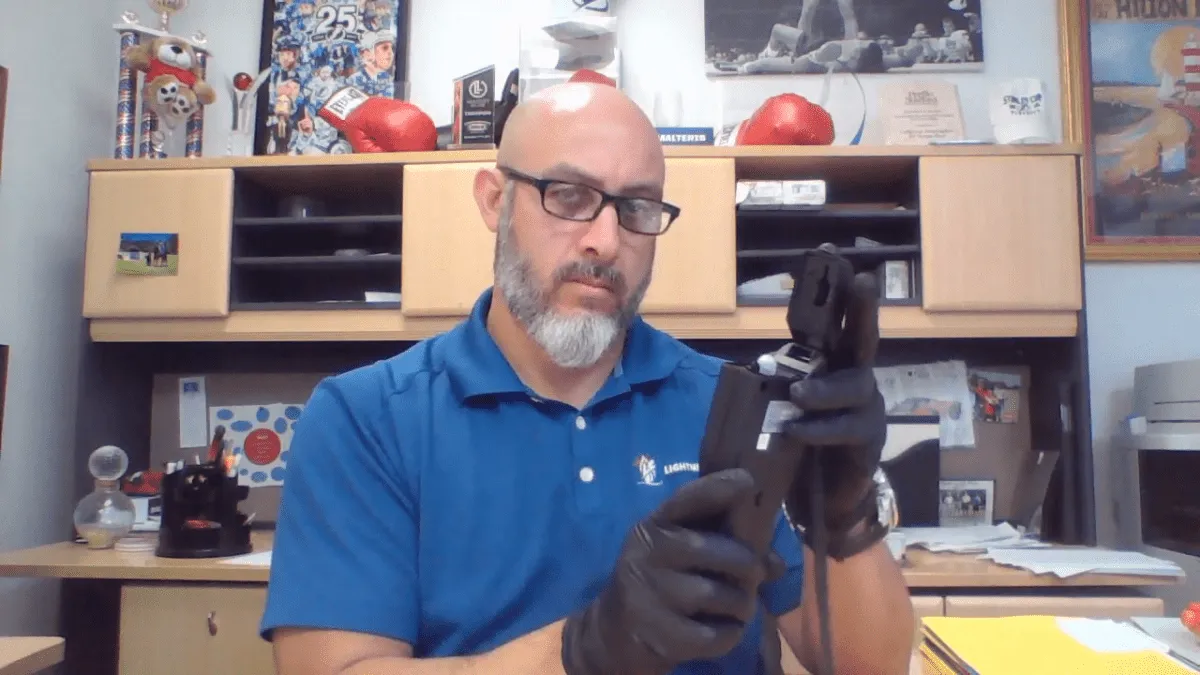How We Test Our Coronavirus (COVID-19) Sanitization Treatments

Let’s talk about the sanitization treatment process we’re using in our customers’ homes, offices, and businesses. More importantly, we’re going to talk about the testing we use during that process.
The most important part of this process is we can test to show that the sanitization we are performing is successful using an ATP meter. If you’re not familiar with ATP, it’s an energy molecule found in all living things, including bacteria and viruses. We take a swab sample before we actually do any kind of cleaning, and then we take another sample at the end after we’ve done the treatment. The premise behind this test is that we will show a significant drop in ATP and, thus, show significant drop in microbial contamination.
LET’S DO THIS SANITIZATION TREATMENT RIGHT HERE ON MY DESK
I work pretty long hours and eat at my desk pretty much every day, so I treat my desk and office regularly. In order to get a realistic view of normal levels of contaminations, we’re going to subject my desk to an everyday scenario. I just received a package. I’m going to rub it all over top of my desk. Then, we’re going to take a sample from there. This will be our beginning threshold.
So now we’re ready to actually do our tests. We’ll take our samples and see what kind of contaminants we have before the actual cleaning. Let’s look at the components of what we’re going to be dealing with.
- First, we have the Hygiena ATP meter
- then we have our actual swab samples that we’re going to take.
- And on here, I have my disinfectant, an EPA registered and certified disinfectant that kills 99.99% of all viruses and bacteria.
We’ll do this treatment after we take the swab, and then we’ll take another swab sample at the end.
We’re going to swab a 4 x 4 square inch area of the desk. I’ll roll the swab over, take a good sample and place the swab back in the tube. There is a reagent in the top of this tube, so we’re going to snap off that plug and squeeze that down in with the plunger. After swishing the tube around for about five seconds, we’re going to drop it into the meter to see what kind of reading we get. This reading will take about 15 seconds.
THAT’S A PRETTY HIGH READING
I’ll go over exactly what these readings mean in just a little bit, but Our reading is 316, which is pretty high. I’ll go over exactly what these readings mean, but for now, that’s our beginning threshold.
Now we’re going to treat the desk and do a post-test to see what we get after sanitization treatment. Treating a desk is pretty simple. I’m going to wash it over here, back and forth. We’ll let the material remain wet for a dwell time of about 10 minutes.
We let the disinfectant sit (or dwell) on the desk for 10 minutes. After this time, we’re ready to take our post sample to see what kind of reading we get after we’ve treated it. We will swab the same 4 x 4 inch area and get a good flex on the stem.
After returning the swab to its tube, we’ll release the reagent and plunger to see how successful our treatment is. When we’re performing these treatments in people’s homes, we’re doing a completely aerosolized treatment. So it’s going everywhere that air, the virus, or bacteria can go. In this localized case, we’re testing a small sample of this desktop, but any actual home or office that we treat will receive a complete envelope treatment, including the AC system as well.
LET’S SEE OUR FINAL READING AFTER SANITIZATION TREATMENT
We will wait 15 seconds again for the results of this second test to find out exactly where we are after sanitization treatment. Amazing, 2 is our final reading.
Before we get into the results of the test that we did on my desk, I want to first talk about what the test results mean. We mentioned already that we have a Hygiena meter which tests for ATP, an energy molecule found in viruses and all living things. This particular meter pushes light through the actual sample that is sent through it, and then it’s measured in RLUs, or relative light units. The higher the amount of RLUs in that actual swab sample, the higher the amount of microbial contaminants.
WHAT’S A NORMAL READING?
As you saw from our test, we started with an initial reading of over 300 RLUs. After finishing the sanitization treatment, we saw a reading of 2 RLUs. Let’s put those numbers into perspective and talk about what the standard readings are for different types of settings.
- For an office or home setting, you generally want your RLUs to be at or below 50.
- In the case of a doctor’s office or a hospital room, we’re looking for the RLUs to be less than 25.
- In a surgical center, operating room, or a food prep area of a restaurant, you want those RLUs to be less than 10.
This is the same meter and test that’s used by the Department of Health to test all of those different areas. And I’m really excited about the process that we use here and the products that we’re using, because as you see, we got a reading of 2 RLUs. This is what you would expect your food to be prepared on. This is also a reading you’d expect in an operating room when having surgery done.
LET LIGHTNING RESTORATION SANITIZE YOUR HOME OR OFFICE
We’re excited about the level of sanitization that we can bring to people’s homes and offices. And if you’re interested in this sanitization treatment, please give us a call. Our number is 855-850-LTNG. Thank you, and be safe and healthy.





